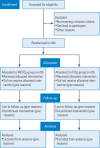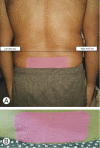Comparing the Effectiveness of the Muscle Energy Technique and Kinesiotaping in Mechanical Sacroiliac Joint Dysfunction: A Non-blinded, Two-Group, Pretest-Posttest Randomized Clinical Trial Protocol
- PMID: 31992024
- PMCID: PMC7904479
- DOI: 10.31616/asj.2019.0300
Comparing the Effectiveness of the Muscle Energy Technique and Kinesiotaping in Mechanical Sacroiliac Joint Dysfunction: A Non-blinded, Two-Group, Pretest-Posttest Randomized Clinical Trial Protocol
Abstract
Study design: Two-group, pretest-posttest randomized clinical trial.
Purpose: To evaluate the efficacy of the muscle energy technique (MET) and Kinesiotaping (KT) in addition to conventional physiotherapy among patients with mechanical sacroiliac joint dysfunction (SIJD).
Overview of literature: Patients with SIJD suffer from lower back and gluteal pain, as well as stiffness, due to restricted pelvic joint movement. To restore function and reduce pain among individuals with mechanical SIJD, the MET and KT may be helpful. However, a limited number of studies have compared MET and KT in mechanical SIJD.
Methods: A total of 40 male and female participants aging between 30 and 50 years experiencing unilateral pain around the gluteal area, groin area, and lower limbs for more than 4 weeks but less than 1 year will be selected. Patients will then be randomized into two groups: METCp (n=20) and KTCp groups (n=20). The METCp group will receive MET along with conventional physiotherapy, while the KTCp group will receive conventional physiotherapy with KT. Both groups will receive three alternating days of treatment per week that will continue for 4 weeks. The modified Oswestry Disability Index, a digital pressure algometer, and sacroiliac joint motion testing will be used for evaluation. Between- and within-group pre- and post-intervention results for mechanical SIJD were compared using the Wilcoxon signed-rank test/paired t-test and Mann-Whitney U -test/independent t -test.
Results: Modified Oswestry Disability Index, digital pressure algometer, and sacroiliac joint motion will be measured at baseline, 2nd week during intervention, and 4th week at the end of intervention.
Conclusions: The present study will provide data regarding the effects of MET and KT among patients with mechanical SIJD.
Keywords: Athletic tape; Low back pain; Manipulation; Muscle energy technique Copyright; Orthotic tape; Pelvic girdle pain.
Conflict of interest statement
No potential conflict of interest relevant to this article was reported.
Figures







Similar articles
-
Short-term effect of muscle energy technique and mechanical diagnosis and therapy in sacroiliac joint dysfunction: A pilot randomized clinical trial.J Bodyw Mov Ther. 2020 Jul;24(3):63-70. doi: 10.1016/j.jbmt.2020.02.017. Epub 2020 Feb 24. J Bodyw Mov Ther. 2020. PMID: 32826010 Clinical Trial.
-
Comparison of Glutues Maximus Activation to Flexion Bias Exercises Along with MET Technique in Subjects with Anterior Rotated Sacroiliac Joint Dysfunction-a Randomised Controlled Trial.Int J Ther Massage Bodywork. 2021 Mar 1;14(1):30-38. eCollection 2021 Mar. Int J Ther Massage Bodywork. 2021. PMID: 33654504 Free PMC article.
-
Effectiveness of muscle energy technique as compared to Maitland mobilisation for the treatment of chronic sacroiliac joint dysfunction.J Pak Med Assoc. 2020 Oct;70(10):1693-1697. doi: 10.5455/JPMA.43722. J Pak Med Assoc. 2020. PMID: 33159735 Clinical Trial.
-
The effectiveness of physiotherapy interventions for sacroiliac joint dysfunction: a systematic review.J Phys Ther Sci. 2017 Sep;29(9):1689-1694. doi: 10.1589/jpts.29.1689. Epub 2017 Sep 15. J Phys Ther Sci. 2017. PMID: 28932014 Free PMC article. Review.
-
Short-Term Effect of Kinesiotaping on Chronic Nonspecific Low Back Pain and Disability: A Meta-Analysis of Randomized Controlled Trials.Phys Ther. 2020 Feb 7;100(2):238-254. doi: 10.1093/ptj/pzz163. Phys Ther. 2020. PMID: 31696916
Cited by
-
Effectiveness of the Muscle Energy Technique versus Osteopathic Manipulation in the Treatment of Sacroiliac Joint Dysfunction in Athletes.Int J Environ Res Public Health. 2020 Jun 22;17(12):4490. doi: 10.3390/ijerph17124490. Int J Environ Res Public Health. 2020. PMID: 32580480 Free PMC article.
References
-
- Cusi MF. Paradigm for assessment and treatment of SIJ mechanical dysfunction. J Bodyw Mov Ther. 2010;14:152–61. - PubMed
-
- Shinde M, Jagtap V. Effect of muscle energy technique and mulligan mobilization in sacroiliac joint dysfunction. Glob J Res Anal. 2018;7:79–81.
Grants and funding
LinkOut - more resources
Full Text Sources
Other Literature Sources
Medical
Research Materials
Miscellaneous

